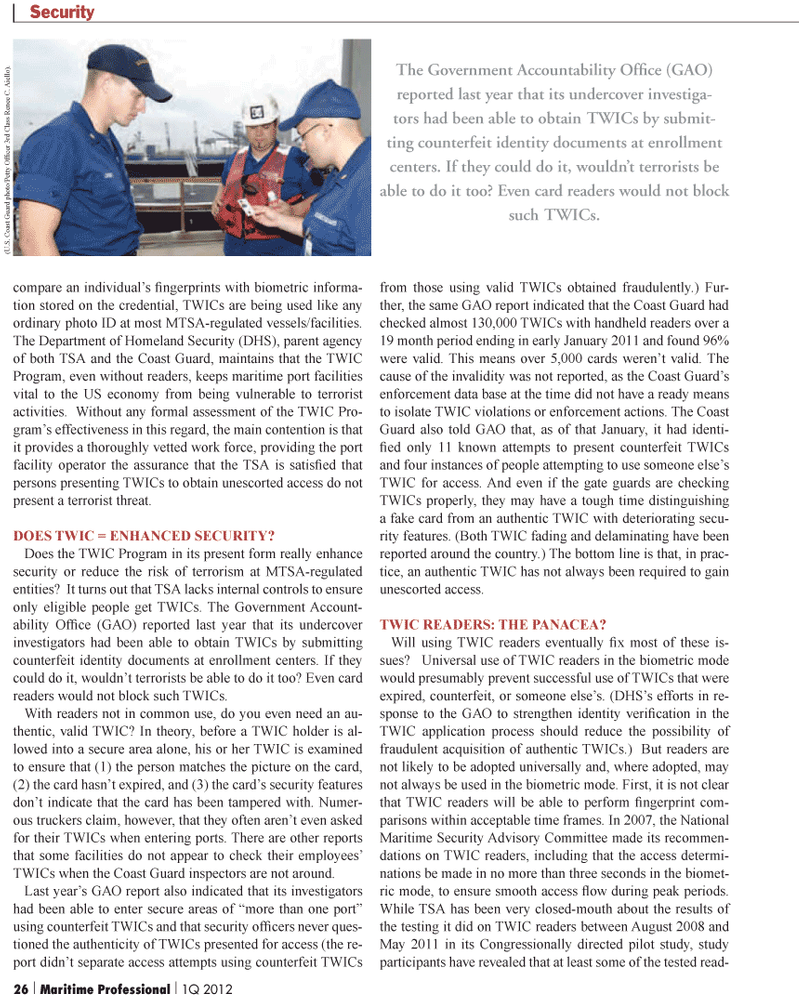
Page 26: of Maritime Logistics Professional Magazine (Q1 2012)
Training & Maritime Security
Read this page in Pdf, Flash or Html5 edition of Q1 2012 Maritime Logistics Professional Magazine
Securitycompare an individual?s Þ ngerprints with biometric informa- tion stored on the credential, TWICs are being used like any ordinary photo ID at most MTSA-regulated vessels/facilities. The Department of Homeland Security (DHS), parent agency of both TSA and the Coast Guard, maintains that the TWIC Program, even without readers, keeps maritime port facilities vital to the US economy from being vulnerable to terrorist activities. Without any formal assessment of the TWIC Pro- gram?s effectiveness in this regard, the main contention is that it provides a thoroughly vetted work force, providing the port facility operator the assurance that the TSA is satis Þ ed that persons presenting TWICs to obtain unescorted access do not present a terrorist threat.DOES TWIC = ENHANCED SECURITY? Does the TWIC Program in its present form really enhance securityor reduce the risk of terrorism at MTSA-regulated entities? It turns out that TSA lacks internal controls to ensure only eligible people get TWICs. The Government Account- ability Of Þ ce (GAO) reported last year that its undercover investigators had been able to obtain TWICs by submitting counterfeit identity documents at enrollment centers. If they could do it, wouldn?t terrorists be able to do it too? Even card readers would not block such TWICs. With readers not in common use, do you even need an au- thentic, valid TWIC? In theory, before a TWIC holder is al- lowed into a secure area alone, his or her TWIC is examined to ensure that (1) the person matches the picture on the card, (2) the card hasn?t expired, and (3) the card?s security features don?t indicate that the card has been tampered with. Numer- ous truckers claim, however, that they often aren?t even asked for their TWICs when entering ports. There are other reports that some facilities do not appear to check their employees? TWICs when the Coast Guard inspectors are not around.Last year?s GAO report also indicated that its investigators had been able to enter secure areas of ?more than one port? using counterfeit TWICs and that security of Þ cers never ques- tioned the authenticity of TWICs presented for access (the re- port didn?t separate access attempts using counterfeit TWICs from those using valid TWICs obtained fraudulently.) Fur- ther, the same GAO report indicated that the Coast Guard had checked almost 130,000 TWICs with handheld readers over a 19 month period ending in early January 2011 and found 96% were valid. This means over 5,000 cards weren?t valid. The cause of the invalidity was not reported, as the Coast Guard?s enforcement data base at the time did not have a ready means to isolate TWIC violations or enforcement actions. The Coast Guard also told GAO that, as of that January, it had identi- Þ ed only 11 known attempts to present counterfeit TWICs and four instances of people attempting to use someone else?s TWIC for access. And even if the gate guards are checking TWICs properly, they may have a tough time distinguishing a fake card from an authentic TWIC with deteriorating secu- rity features. (Both TWIC fading and delaminating have been reported around the country.) The bottom line is that, in prac- tice, an authentic TWIC has not always been required to gain unescorted access.TWIC READERS: THE PANACEA? Will using TWIC readers eventually Þ x most of these is- sues? Universal use of TWIC readers in the biometric mode would presumably prevent successful use of TWICs that were expired, counterfeit, or someone else?s. (DHS?s efforts in re- sponse to the GAO to strengthen identity veri Þ cation in the TWIC application process should reduce the possibility of fraudulent acquisition of authentic TWICs.) But readers are not likely to be adopted universally and, where adopted, may not always be used in the biometric mode. First, it is not clear that TWIC readers will be able to perform Þ ngerprint com- parisons within acceptable time frames. In 2007, the National Maritime Security Advisory Committee made its recommen- dations on TWIC readers, including that the access determi- nations be made in no more than three seconds in the biomet-ric mode, to ensure smooth access ß ow during peak periods. While TSA has been very closed-mouth about the results of the testing it did on TWIC readers between August 2008 and May 2011 in its Congressionally directed pilot study, study participants have revealed that at least some of the tested read- The Government Accountability Of? ce (GAO) reported last year that its undercover investiga- tors had been able to obtain TWICs by submit- ting counterfeit identity documents at enrollment centers. If they could do it, wouldnt terrorists be able to do it too? Even card readers would not block such TWICs. (U.S. Coast Guard photo/Petty OfÞ cer 3rd Class Renee C. Aiello). 26 | Maritime Professional |1Q 2012

 25
25

 27
27
